Research on Solving the Structural Instability of Composite Propellants by Using Non-Ablative Cladding Layers
Abstract
1. Introduction
2. Description of Abnormal Phenomena in Interior Ballistic Curves
3. Simulation Analysis of the Flow Field
3.1. Physical Model
3.2. Mathematical Models
- (a)
- The regression of the combustion surface adheres to the parallel layer theory, ensuring uniform regression distance for each combustion surface;
- (b)
- The mixed gas resulting from combustion behaves as an ideal compressible gas. The specific heat capacity at constant pressure remains constant and does not vary with temperature;
- (c)
- The effects of erosion combustion are disregarded;
- (d)
- The results obtained from the quasi-steady-state simulation of the flow field at different regression stages of the burning surface represent the actual flow field within the combustion chamber at those respective times.
3.3. Composite Propellant Parameters and Boundary Conditions
- (A)
- The 0.5 mm thin layer of the fluid domain on the burning surface of the propellant is designated as the source term. The combustion of the propellant is simulated based on its properties and the properties of the gas. The burning surface can input the gas with corresponding mass, momentum, and energy;
- (B)
- The simulation only considers the fluid domain, with its walls being adiabatic. Energy exchange with the propellant and shell is not accounted for;
- (C)
- The outlet is set as the pressure-outlet with a pressure of 101,325 Pa and an ambient temperature of 323 K. In the supersonic calculation of the ideal gas, outlet properties will be calculated using the difference method;
- (D)
- Considering the symmetry of the model, the model section is set as the symmetric boundary.
3.4. Grid Independence Verification
3.5. Validation Study on the Model
3.6. Analysis of Simulation Results
4. Analysis of Structural Integrity of Grain under Unbalanced Pressure
5. Utilizing Non-Ablative Cladding Layers for Improvement
5.1. Simulation Analysis of the Non-Ablative Cladding Layer Scheme
5.2. Experimental Verification of the Non-Ablative Cladding Layer Scheme
6. Conclusions
Author Contributions
Funding
Data Availability Statement
Conflicts of Interest
References
- Hugget, C.; Bartley, C.E.; Mills, M.M. Solid Propellant Rockets; Princeton University Press: Princeton, NJ, USA, 2015; pp. 1–176. [Google Scholar]
- Wei, X.; Zhou, J.; Li, H.; Shu, H. Research progress on structural integrity analysis of solid propellant grain. J. Ordnance Equip. Mot. 2022, 1, 19–26. [Google Scholar] [CrossRef]
- Liu, M.; Xiong, L.; Huang, H. Experimental and numerical investigation on agglomeration of aluminum during combustion process of aluminized composite propellant. Therm. Sci. Eng. Prog. 2024, 49, 102505. [Google Scholar] [CrossRef]
- Zhang, P.; Han, W.; Zhou, D. Structural Integrity Assessment of an NEPE Propellant Grain Considering the Tension-Compression Asymmetry in Its Mechanical Property. Polymers 2023, 15, 3339. [Google Scholar] [CrossRef] [PubMed]
- Wu, W.; Fan, Z.; Yuan, J.; Shen, Z. Analysis of relaxation modulus, tension-compression properties and temperature sensitivity of solid propellant. J. Solid Rocket Technol. 2022, 45, 237–243. [Google Scholar]
- Zong, L.H.; Du, C.; Lu, S.; Yao, D.; Gao, J.; Sha, B.-L. Simulation on pressure cure of solid rocket motor grain. J. Solid Rocket Technol. 2015, 38, 653–656. [Google Scholar]
- Gong, J.; Jin, B.; Gong, W.; Deng, Z.; Zhang, Z. Numerical analysis on structural integrity of finocyl grain under ignition loading. J. Natl. Univ. Def. Technol. 2022, 44, 108–113. [Google Scholar]
- Liu, Z.; Zhou, Y.; Zhang, B. Structural integrity analysis on grains of solid rocket motor at low temperature ignition. J. Solid Rocket Technol. 2015, 38, 351–355. [Google Scholar]
- Değirmenci, E.; Evci, C.; Işık, H.; Macar, M.; Yılmaz, N.; Dirikolu, M.H.; Çelik, V. Thermo-mechanical analysis of double base propellant combustion in a barrel. Appl. Therm. Eng. 2016, 102, 1287–1299. [Google Scholar] [CrossRef]
- Deng, K.; Zhang, L.; Pang, A.; Yu, R.; Yang, L.; Xin, P. Analysis on structural integrity of a free loading solid propellant grains under ignition loading at low temperature. J. Solid Rocket Technol. 2018, 41, 428–434. [Google Scholar]
- Zheng, W.; Chen, J.-B.; Pei, J.-F.; Ma, L.; Wang, J.-N.; Song, X.-D.; Geng, C.-H. Experimental Study on Free Loading of Rocket Motor with Large Aspect Ratio. Chin. J. Explos. Propellants 2020, 4, 433–436, 441. [Google Scholar] [CrossRef]
- Zhang, Z.; Li, J.; Mei, K.; Wang, J.; Wang, N. Study on Factors Affecting Initial Pressure Peak in Solid Rocket Motor with Multiple Tubular grains. Propuls. Technol. 2020, 3, 632–641. [Google Scholar] [CrossRef]
- Liu, Y.; Wang, H.; Tao, R.; Zhu, D. Effects of ignition process on the internal ballistics of small-size solid rocket motor. Chin. J. Energetic Mater. 2013, 21, 75–79. [Google Scholar]
- Guan, D.; Li, S.; Liu, Z.; Wang, N. Influence of Lateral Acceleration on Ignition Transients of Solid Rocket Motor. Acta Armamentarii 2021, 42, 1877–1887. [Google Scholar]
- Chen, Z.; Han, W.; Zhang, Z.; Wu, M.; Fang, H. Experimental study on combustion instability in a large aspect ratio solid rocket motor. J. Solid Rocket Technol. 2022, 4, 631–638. [Google Scholar] [CrossRef]
- Zhang, X.; Gao, B.; Gan, X.; Ma, L.; Zhou, Y. Impacts of Flight Acceleration on Combustion Instability of Solid Rocket Motor. J. Astronaut. 2019, 40, 972–976. [Google Scholar]
- Hu, D.; He, G.; Liu, P.; Wang, Z. Study on combustion instability of solid rocket motor with finocyl grain. J. Solid Rocket Technol. 2010, 5, 502–506. [Google Scholar] [CrossRef]
- Du, J.; Yang, R.; Li, D.; Xv, Y. Stability analysis of reinforced concrete tower of MW grade wind turbine. J. Sol. Energy 2021, 3, 9–14. [Google Scholar] [CrossRef]
- Li, Y.B.; Pan, Q.; Huang, M.H.; Li, L. Set-based parametric modeling, buckling and ultimate strength estimation of stiffened ship structures. J. Cent. South Univ. 2019, 26, 1958–1975. [Google Scholar] [CrossRef]
- Kendall, R.P.; Votta, L.G.; Post, D.E.; Moyer, E.T.; Morton, S.A. Verification and Validation in CREATE Multiphysics HPC Software Applications. Comput. Sci. Mot. 2017, 19, 18–26. [Google Scholar] [CrossRef]
- Menter, F.R. Zonal two equation k-ω turbulence models for aerodynamic flows. In Proceedings of the 23rd Fluid Dynamics, Plasmadynamics, and Lasers Conference, Orlando, FL, USA, 6–9 July 1993. [Google Scholar]
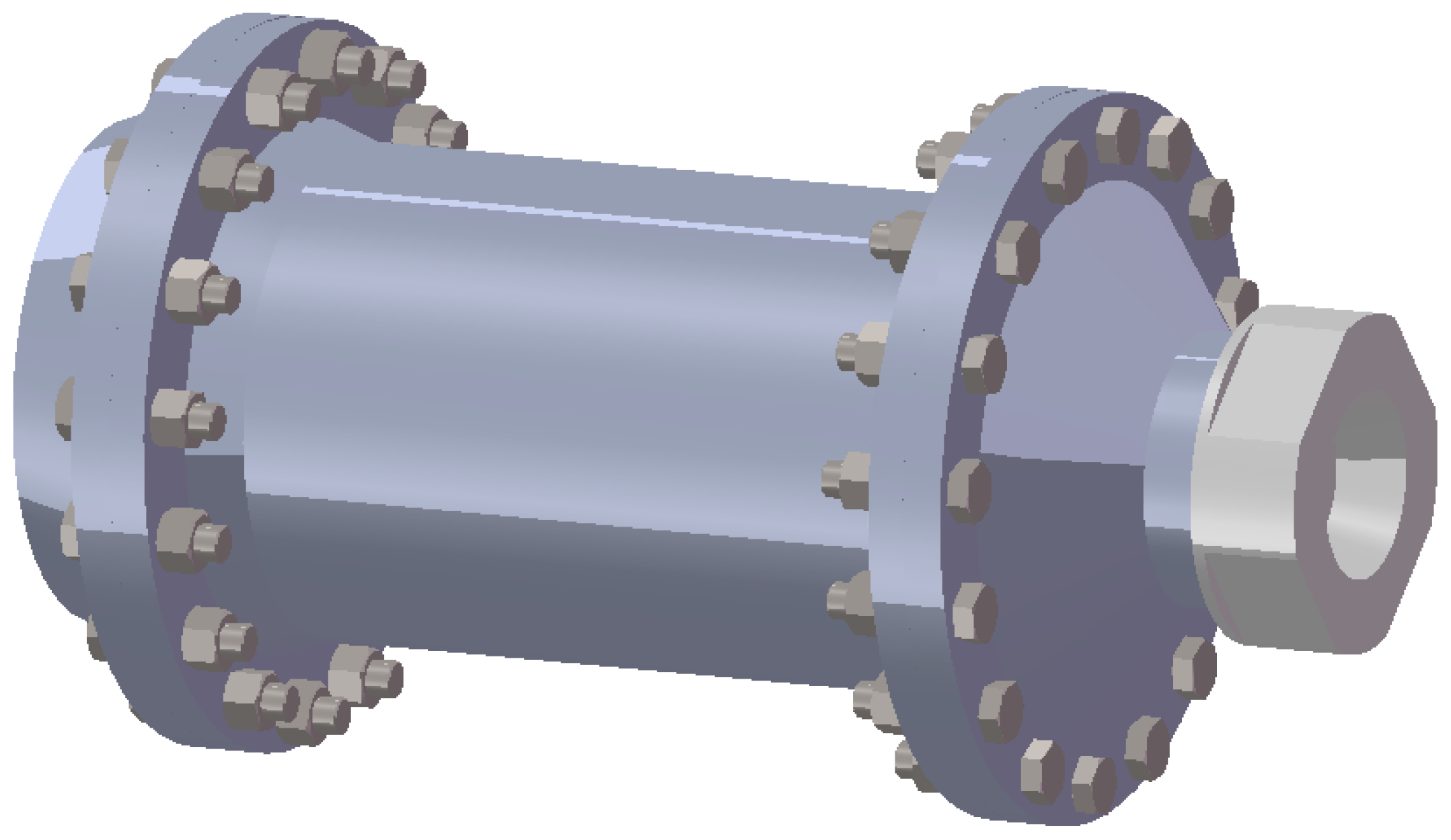
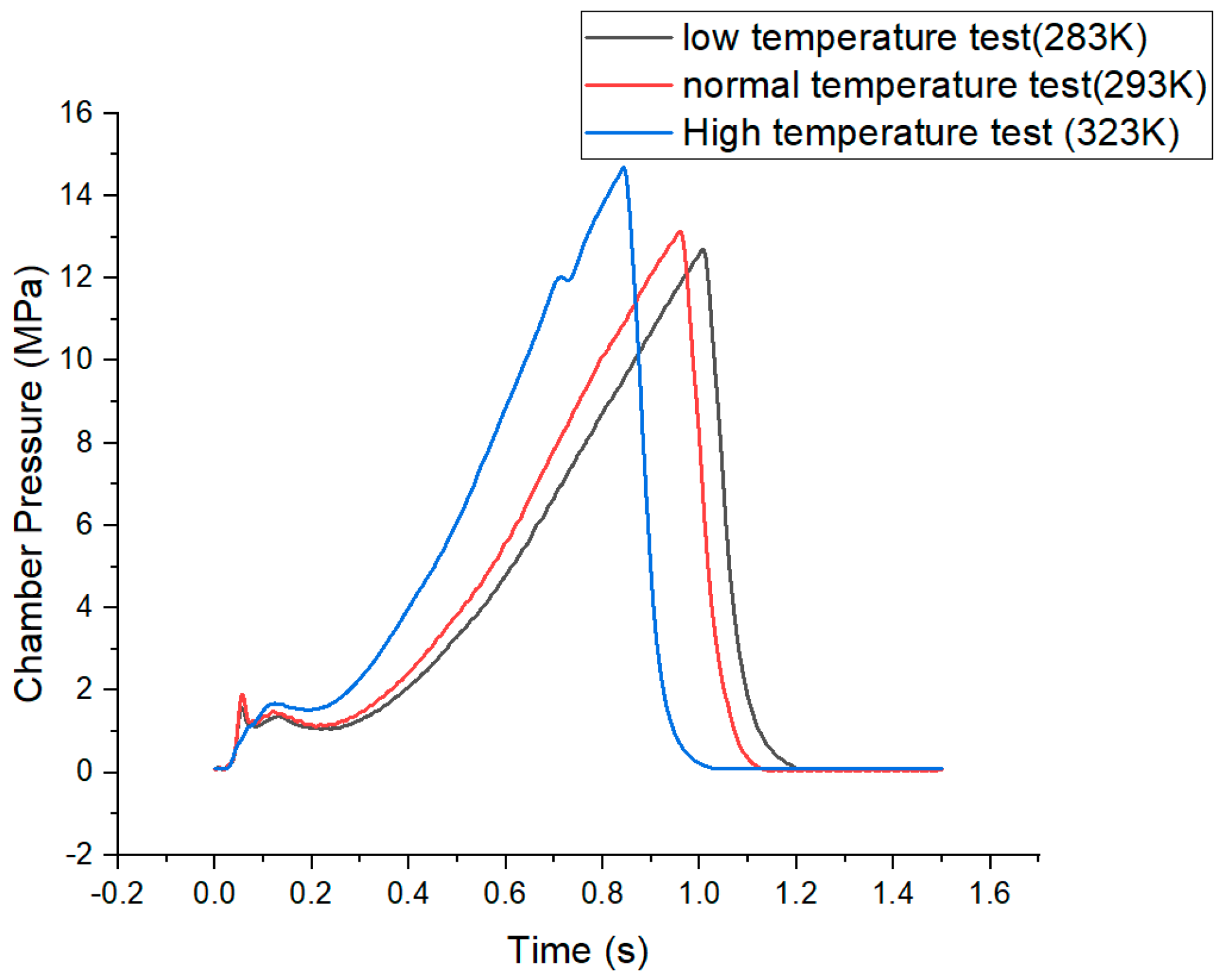

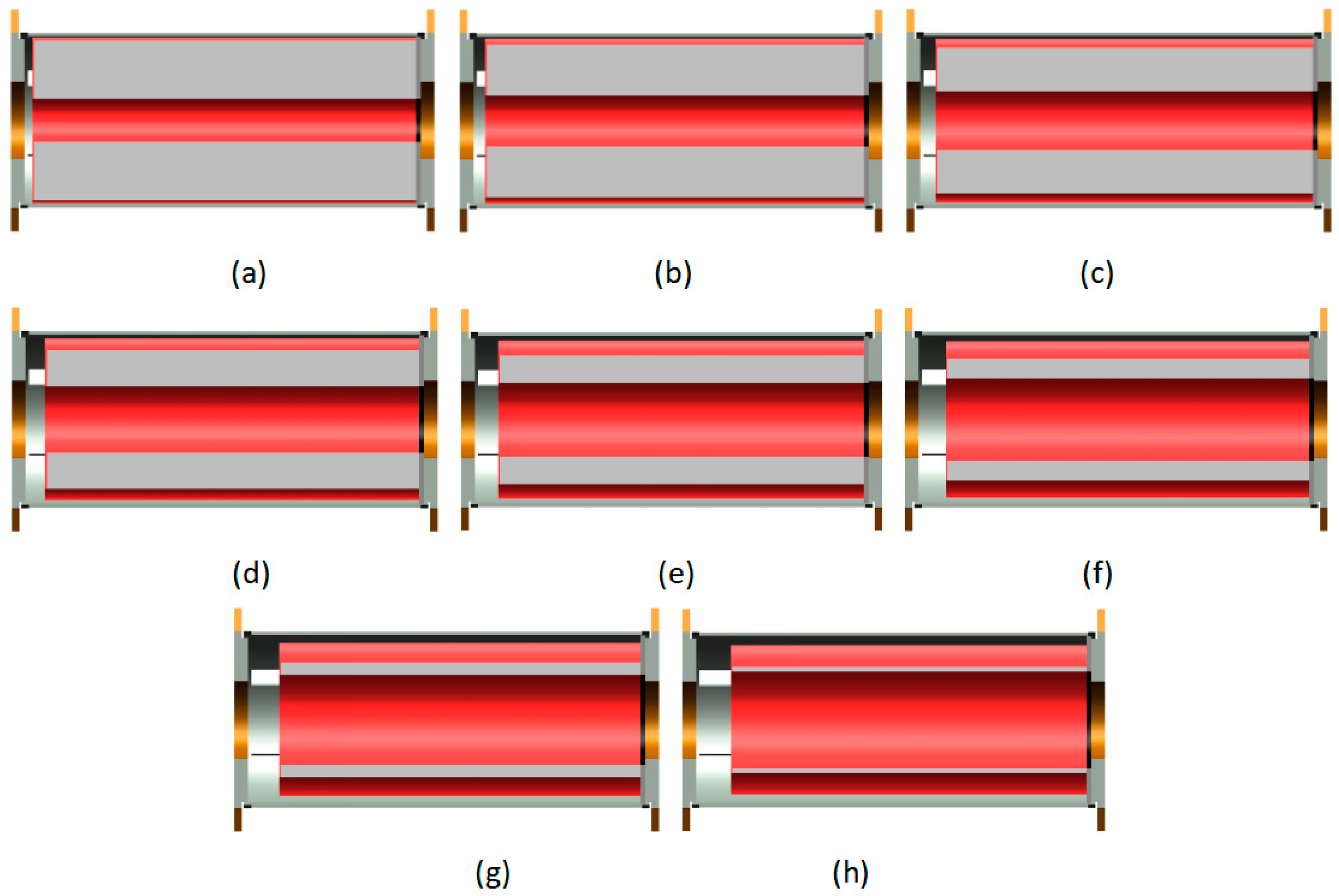
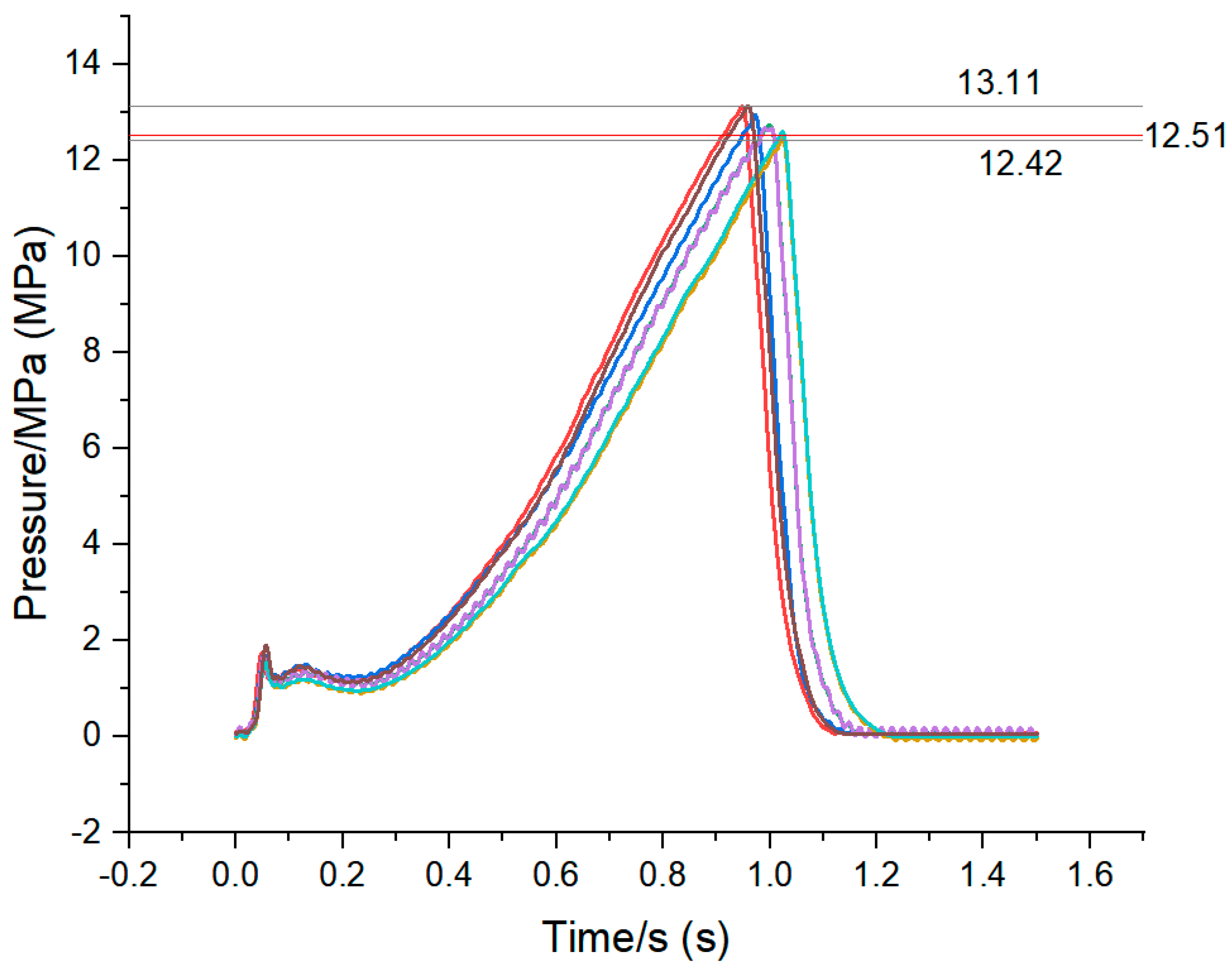
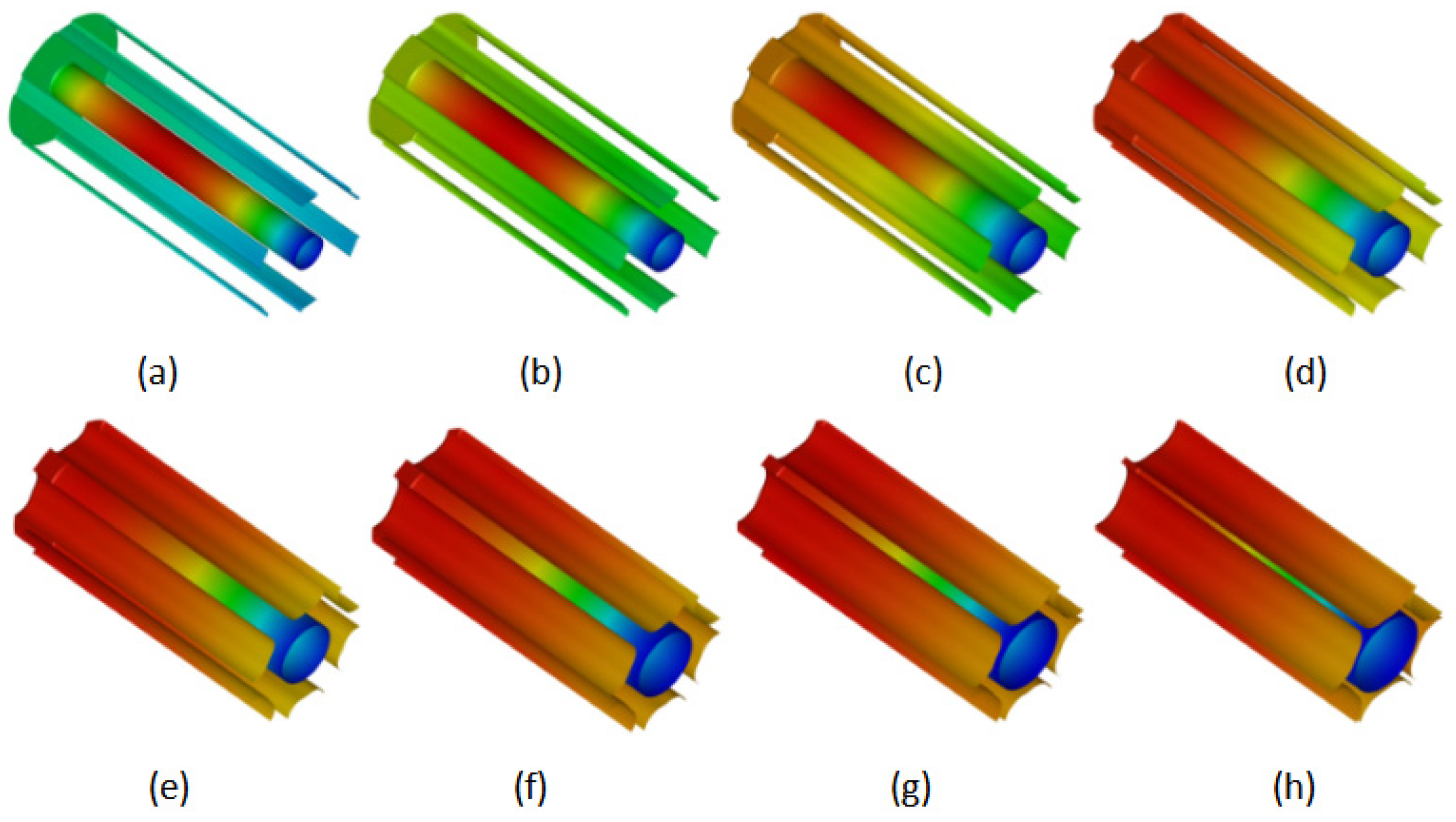
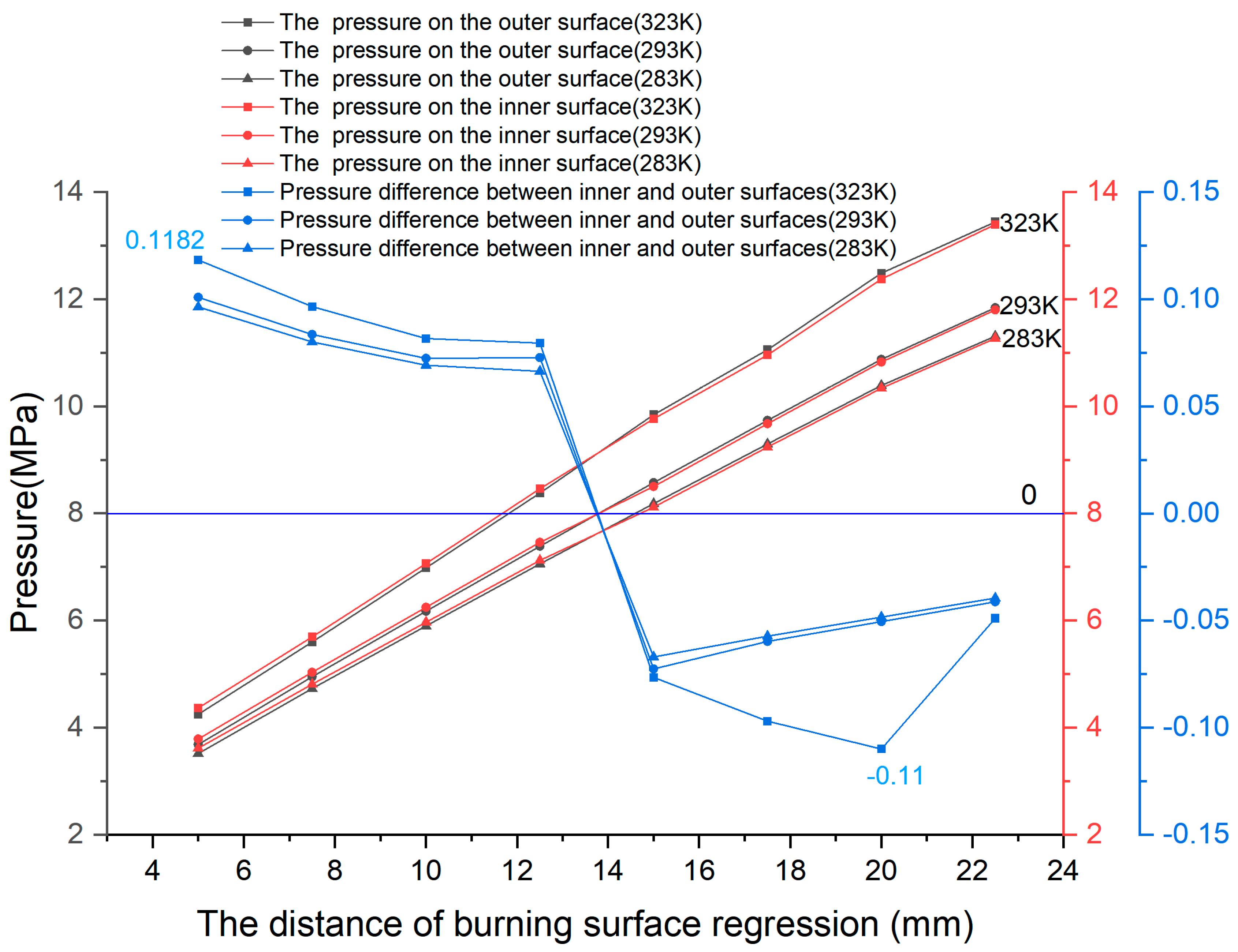
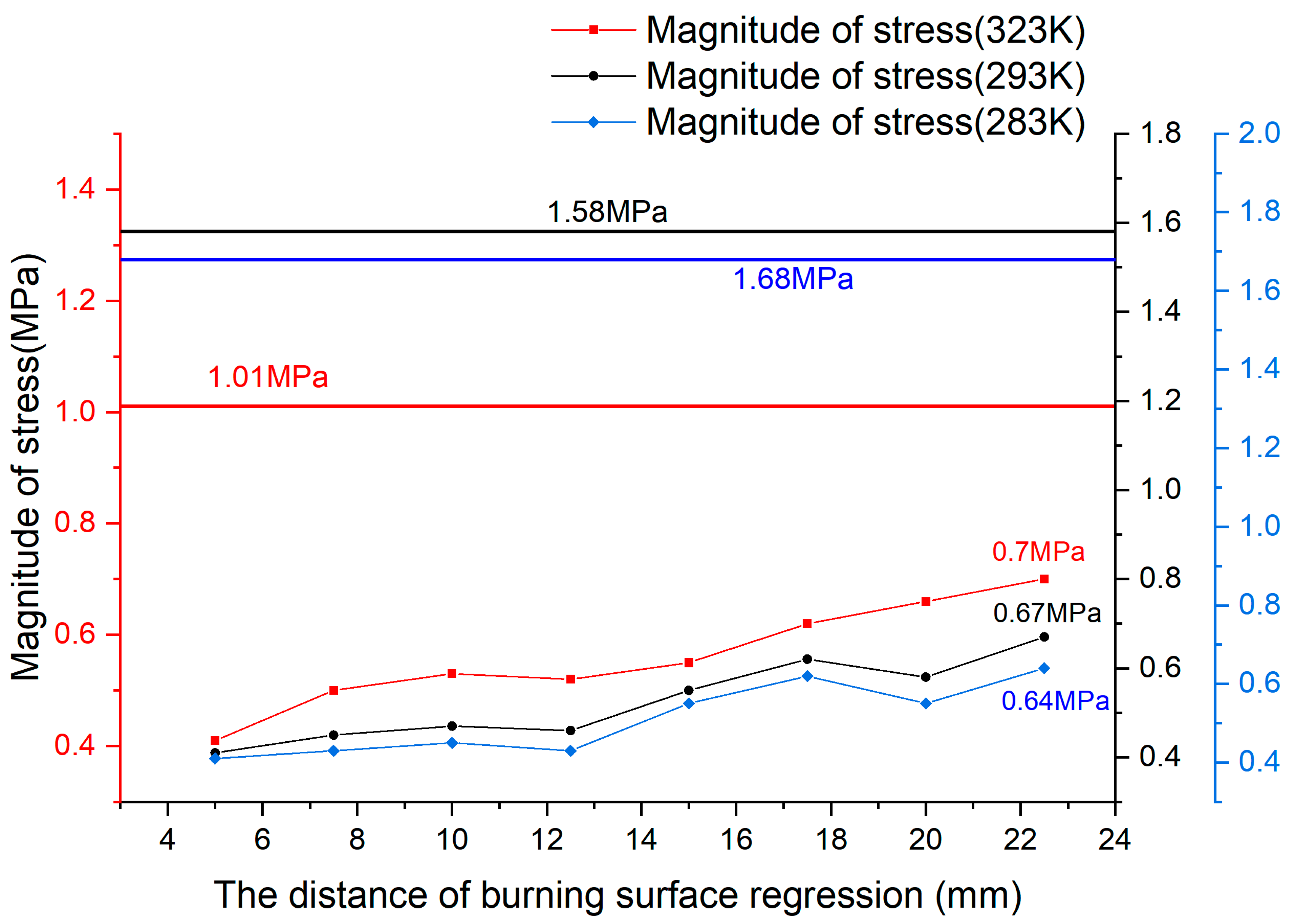
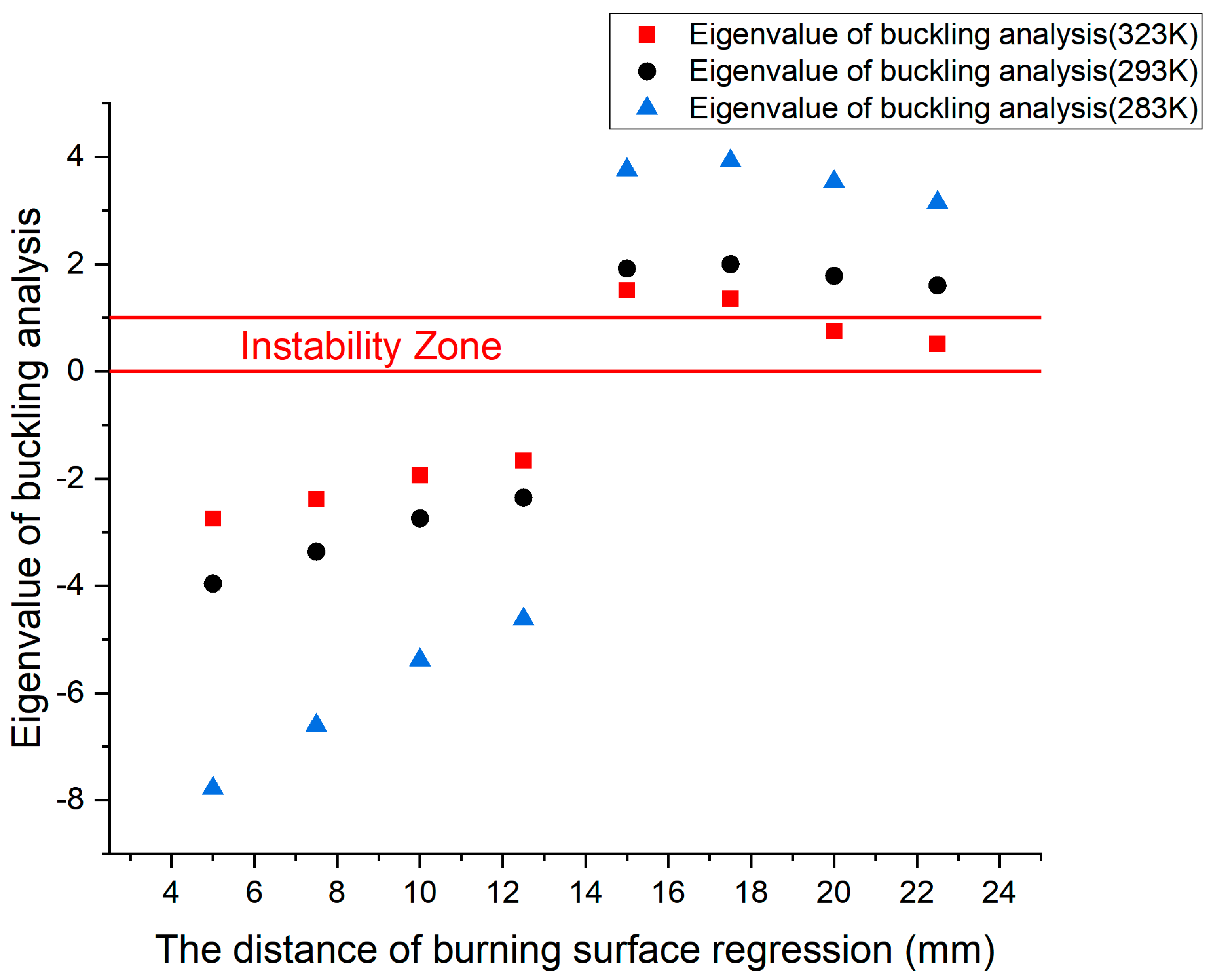
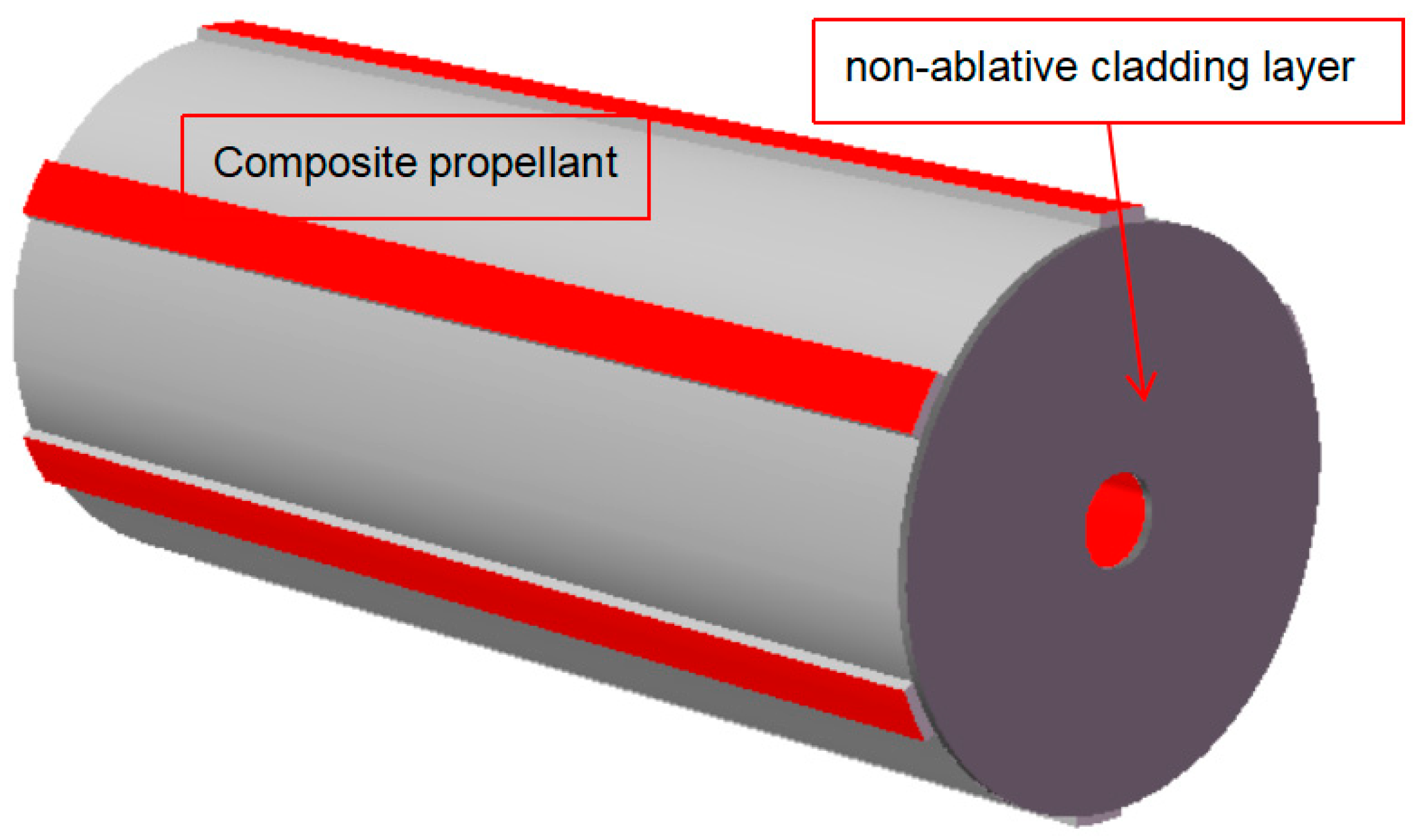



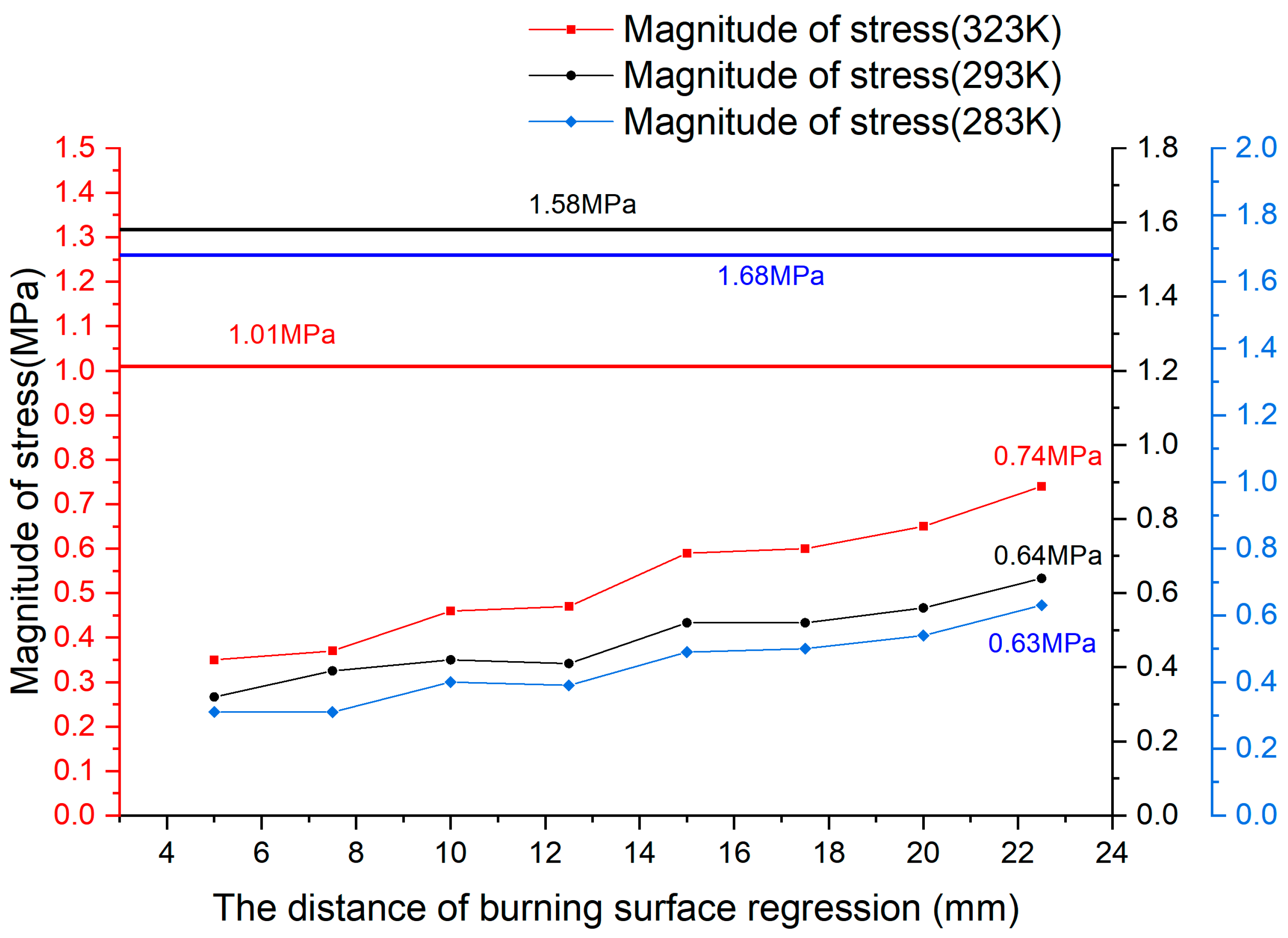
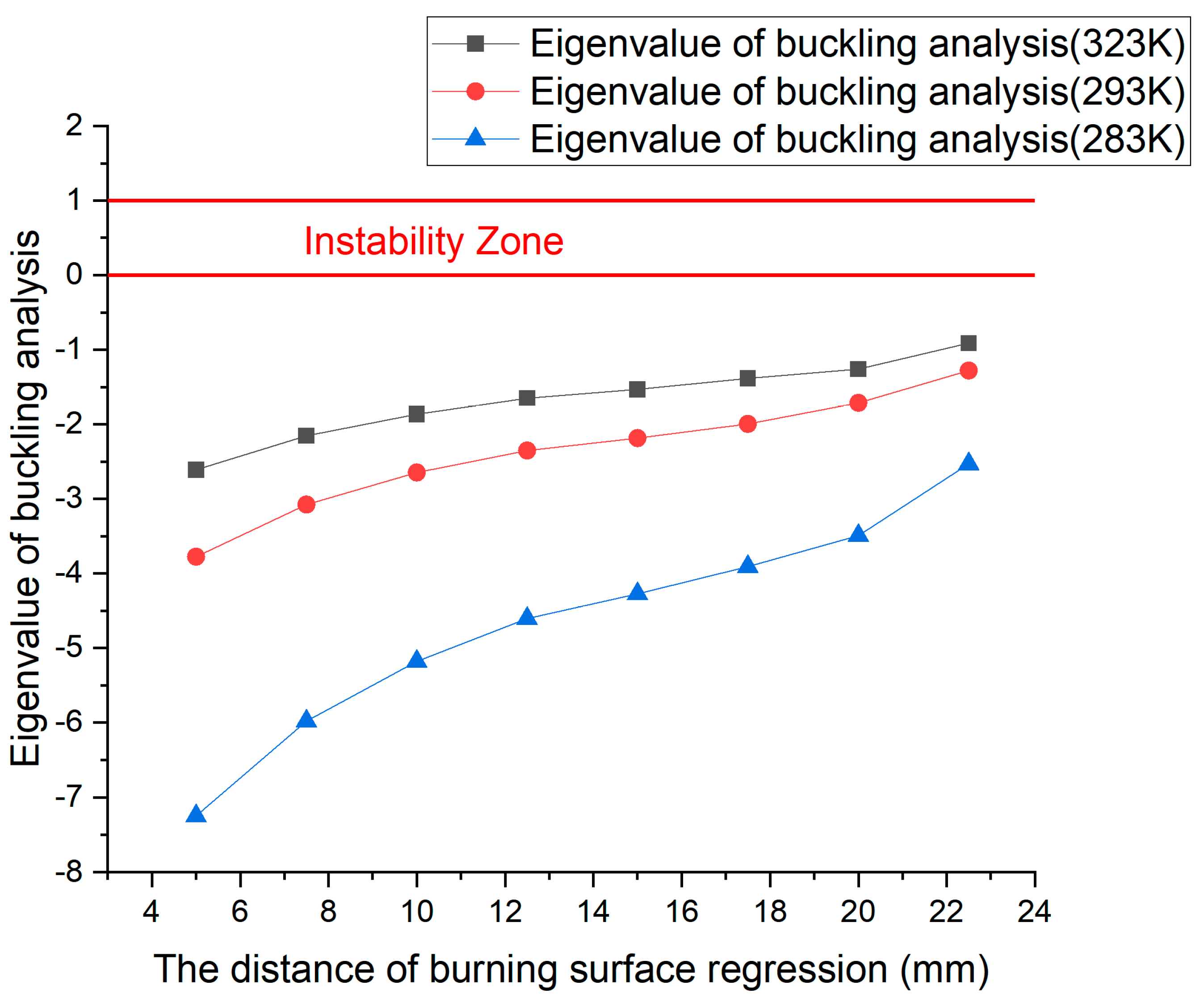

| Objects | Parameters | Values |
|---|---|---|
| The composite propellant | Density/(kg/m3) | 1660 |
| Burning rate under 10 MPa and 300 K/(mm/s) | 37 | |
| The pressure sensitivity coefficient n | 0.3 | |
| The temperature sensitivity coefficient | 0.0032 | |
| The gas | The total gas temperature Tc/(K) | 1380 |
| The molecular weight/(g/mol) | 26.885 | |
| The specific heat capacity/(J/(Kg*K)) | 2975.3 |
| The Grid Size | Number of Grids | Pressure Calculated by Simulation (MPa) |
|---|---|---|
| 1.5 mm | 6,024,178 | 12.51 |
| 2 mm | 4,208,421 | 12.52 |
| 2.5 mm | 2,085,216 | 12.51 |
| 3 mm | 1,090,030 | 12.41 |
| 3.5 mm | 854,927 | 12.29 |
| 4 mm | 722,313 | 12.25 |
| 4.5 mm | 673,577 | 12.25 |
| 5 mm | 573,433 | 12.02 |
| The Ambient Temperature | Pressure Calculated by Simulation (MPa) | The Pressure Obtained from the Experiment (MPa) | Error |
|---|---|---|---|
| 283 K | 11.89 | 12.68 | 6.2% |
| 293 K | 12.51 | 13.11 | 4.6% |
| 323 K | 13.95 | 14.61 | 4.5% |
| The Ambient Temperature | The Young’s Elastic Modulus (MPa) | The Poisson’s Ratio | The Ultimate Strength (MPa) |
|---|---|---|---|
| 283 K | 15 | 0.485 | 1.68 |
| 293 K | 8 | 0.488 | 1.58 |
| 323 K | 3 | 0.495 | 1.01 |
Disclaimer/Publisher’s Note: The statements, opinions and data contained in all publications are solely those of the individual author(s) and contributor(s) and not of MDPI and/or the editor(s). MDPI and/or the editor(s) disclaim responsibility for any injury to people or property resulting from any ideas, methods, instructions or products referred to in the content. |
© 2024 by the authors. Licensee MDPI, Basel, Switzerland. This article is an open access article distributed under the terms and conditions of the Creative Commons Attribution (CC BY) license (https://creativecommons.org/licenses/by/4.0/).
Share and Cite
Zhang, G.; Zhan, M.; Feng, W.; Tan, Y.; Liu, Y.; Hui, W. Research on Solving the Structural Instability of Composite Propellants by Using Non-Ablative Cladding Layers. Aerospace 2024, 11, 326. https://doi.org/10.3390/aerospace11040326
Zhang G, Zhan M, Feng W, Tan Y, Liu Y, Hui W. Research on Solving the Structural Instability of Composite Propellants by Using Non-Ablative Cladding Layers. Aerospace. 2024; 11(4):326. https://doi.org/10.3390/aerospace11040326
Chicago/Turabian StyleZhang, Gang, Mingming Zhan, Wen Feng, Youwen Tan, Yang Liu, and Weihua Hui. 2024. "Research on Solving the Structural Instability of Composite Propellants by Using Non-Ablative Cladding Layers" Aerospace 11, no. 4: 326. https://doi.org/10.3390/aerospace11040326
APA StyleZhang, G., Zhan, M., Feng, W., Tan, Y., Liu, Y., & Hui, W. (2024). Research on Solving the Structural Instability of Composite Propellants by Using Non-Ablative Cladding Layers. Aerospace, 11(4), 326. https://doi.org/10.3390/aerospace11040326






